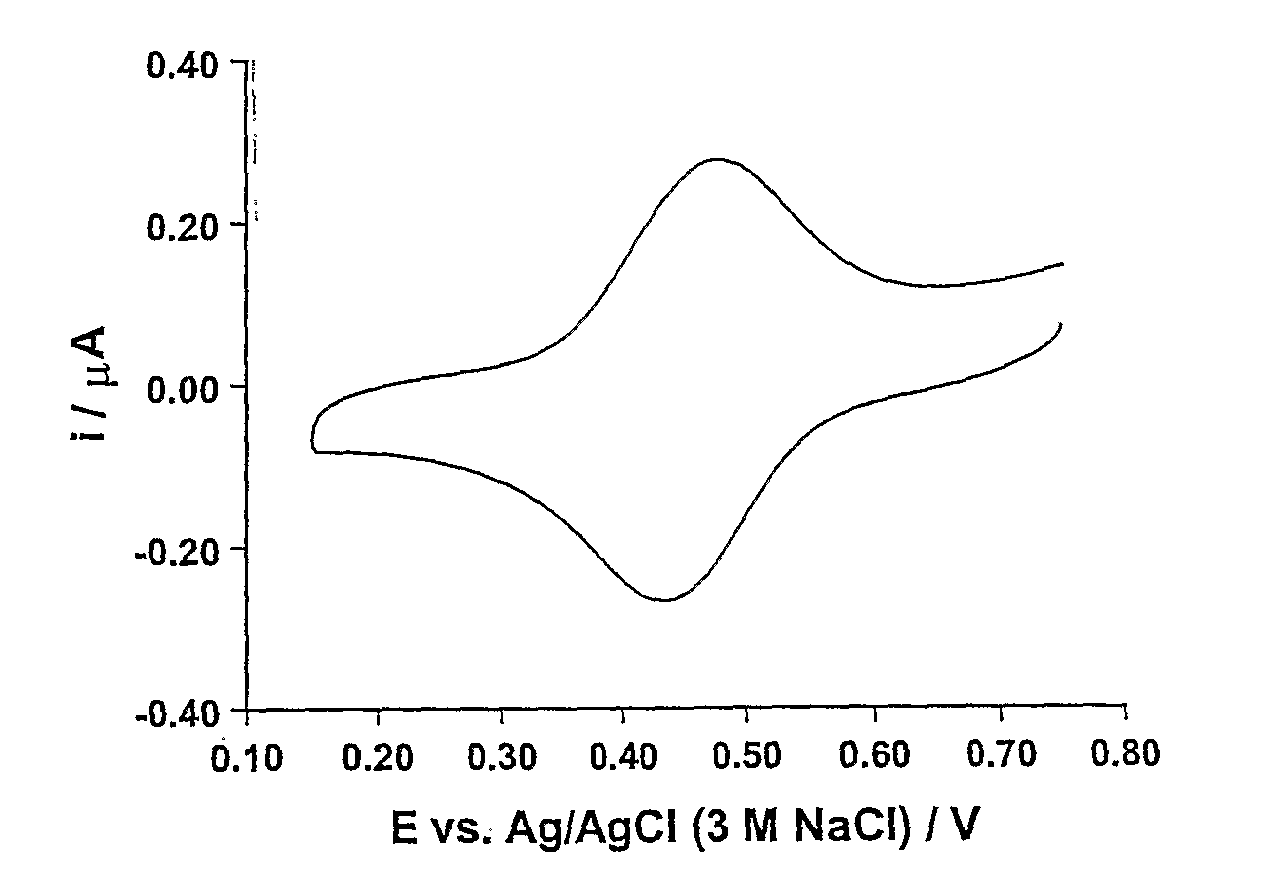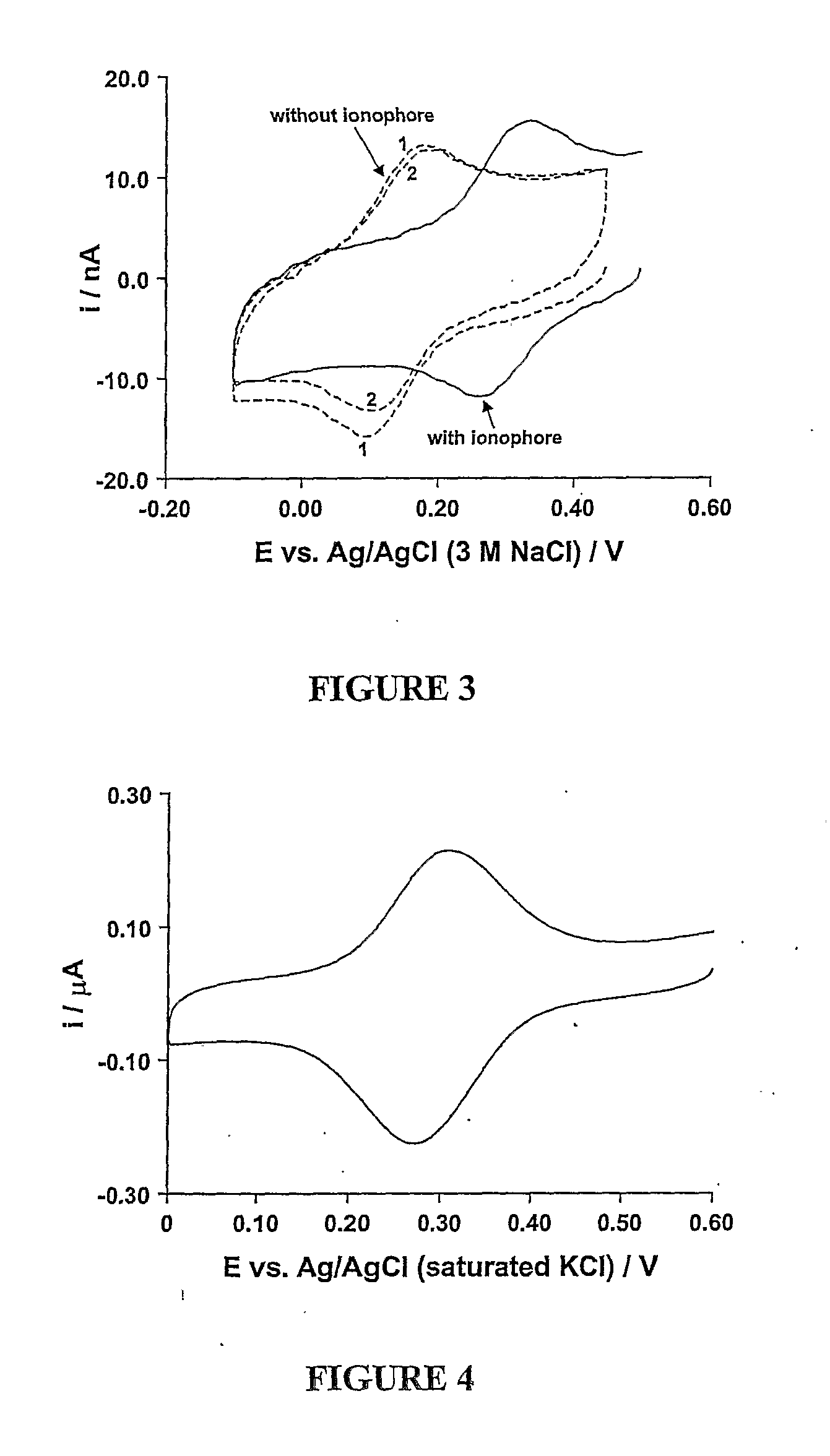Voltammetric Ion Sensor
a technology of ion sensor and voltage, applied in the direction of liquid/fluent solid measurement, instruments, electrochemical variables of materials, etc., can solve the problems of large sample size required for measurement, limited ise minimum size, and unsatisfactory slowness, so as to reduce the response time, the effect of accurate results and the ability to change the response time of the devi
- Summary
- Abstract
- Description
- Claims
- Application Information
AI Technical Summary
Benefits of technology
Problems solved by technology
Method used
Image
Examples
example 1
Production of Device
[0069] A conventional three-electrode cell was employed, with 1.5 mm diameter glassy carbon (GC) electrode as the sensing electrode, and a Pt wire as the counter electrode. A Ag / AgCl (3 M NaCl) electrode was used to provide the reference potential scale. The GC sensing electrode was polished with a 0.3 μm Al2O3 (Buehler) slurry, washed successively with water and acetone and dried with tissue paper.
[0070] A coating composition was then prepared by combining 1 ml PVC solution (0.15 g PVC dissolved in 8 ml THF), with 37.5 μl NPOE (plasticizer) which contains 2.5 mM TCNQ (electroactive species), 25 mM valinomycin (ionophore) and 10 mM TBATPB (ionic salt). A small volume (less than 1 μl) of coating solution was introduced on to the surface of the glassy carbon (GC) electrode using a micropipette. The sensor was then left in the air for about 5 minutes to allow the THF to evaporate.
example 2
K+ Sensor
[0071] A measurement was carried out using a 0.1 mol dm−3 solution of KCl as the fluid. The fluid was contacted with the electrodes of a device produced in accordance with Example 1 and a potential scan was applied to the sensing electrode, the scan involving increasing the applied potential from substantially zero to 0.8V and then reducing the applied potential to zero again. The current was measured during application of the scan. A voltammogram showing the results is depicted in FIG. 1. Scan rates of between 10 mVs−1 and 1 Vs−1 were used and the measurement was found to be independent of the scan rate within this range.
[0072] The selectivity of this sensor was determined in relation to Na+, NH4+ and Ca2+ ions using the fixed interference method recommended by IUPAC (Morf: The Principles of Ion Selective Electrodes and of Membrane Transport, Elsevier: Amsterdam, 1981). The concentration of interference ion was fixed at 1.0 mol dm−3 and the concentration of target ion (K...
example 3
Alternative K Sensor
[0073] A sensor was produced in the same manner as described in Example 1, but replacing the NPOE plasticizer with the ionic liquid aph4.cph12 and eliminating the ionic salt (TBATPB). A measurement was carried out using a 0.1 mol dm−3 solution of KCl as the fluid in the same manner as is described in Example 2. The resulting voltammogram is depicted in FIG. 3. The solid line indicates the result for the above described sensor, whilst the dotted lines depict the result for a sensor which varied from the above only in that an ionophore was not used. In the absence of ionophore, the transfer of K+ into the membrane is less favourable resulting in movement of the oxidation and reduction peaks and decreasing peak current with cycle number due to redox active species transferring into the aqueous phase.
PUM
| Property | Measurement | Unit |
|---|---|---|
| volumes | aaaaa | aaaaa |
| diameter | aaaaa | aaaaa |
| volume | aaaaa | aaaaa |
Abstract
Description
Claims
Application Information
 Login to View More
Login to View More - R&D
- Intellectual Property
- Life Sciences
- Materials
- Tech Scout
- Unparalleled Data Quality
- Higher Quality Content
- 60% Fewer Hallucinations
Browse by: Latest US Patents, China's latest patents, Technical Efficacy Thesaurus, Application Domain, Technology Topic, Popular Technical Reports.
© 2025 PatSnap. All rights reserved.Legal|Privacy policy|Modern Slavery Act Transparency Statement|Sitemap|About US| Contact US: help@patsnap.com



